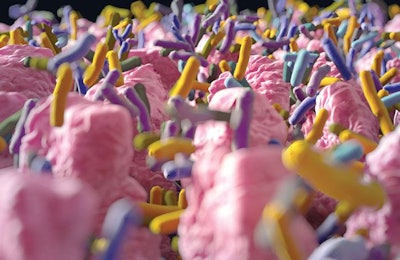
Advancements in genome sequencing technology are opening new possibilities in manipulating the microbiome to improve animal health. Powered by this progress in microbiology, soon two new methods may be available to help establish and feed a healthy animal microbiome.
In an interview with WATT PoultryUSA, Dr. Michael Kogut, project leader and research microbiologist with the U.S. Department of Agriculture’s Agricultural Research Service, said scientific progress is moving toward bringing two techniques designed to stimulate helpful microbes to the chicken industry in the near future.
Kogut, who presented at the Animal Microbiome Congress USA in Overland Park, Kansas, on March 22, 2018, said researchers are currently investigating the techniques of microbiota-based metabolite therapy and using immunoregulatory commensals in animal feeding. Both methods seek to take advantage of new knowledge of the functions of certain microbes and use it to promote bird health.

Mike Kogut, USDA Agricultural Research Service | Photo by Austin Alonzo
1. Microbiota metabolite-based therapy
This technique involves using the metabolites of certain microbiomes and using those metabolites to directly feed and support helpful microbes in the gut. Metabolites are carbohydrates, amino acids or some other nutritive component that can be used to feed, and encourage the growth of, certain microbes.
The process is somewhat similar to using probiotics and prebiotics, which are designed to stimulate the growth of certain helpful microbes, but is much more focused. Microbes fed as a probiotic are also challenged to establish a niche in an environment already populated with trillions of microbes. Kogut said metabolites could be purified, encapsulated and fed to animals so they can be released in the exact part of the gut where they will benefit the desired microbes already established in the gut.
Right now, experiments are on-going and he estimates it will take a few more years before this type of therapy is commercially available. The biggest remaining question, Kogut said, is whether or not the metabolites will reach the desired location in the gut and whether they will feed the right microbes.
2. Immunoregulatory commensals
Another therapy that may soon find application in the chicken industry is the use of immunoregulatory commensals. In effect, Kogut said, these are microbes which are known to effect the immune system and regulate immune response.
The concept involves isolating certain microbes, using them to create a probiotic supplement and then feeding it to an animal in order to achieve the desired immune system response. Kogut said this could vary, as some microbes will be useful fighting certain conditions based on their ability to stimulate or depress immune system responses.
The problem with this process is the current inability to culture the microbes known to effect the immune system and the relative lack of knowledge of how the microbes will behave inside the gut of a chicken or a turkey. Kogut said just because a microbe does something in the gut of a human or mouse doesn’t necessarily mean it will do the same thing for a bird. Answering this question is made harder by the inability to grow the immunoregulatory microbes in vitro.
This is not an insurmountable hurdle, however. The progress in genome sequencing is making it cheaper, and faster, for scientists to identify and classify the array of species living in the poultry microbiome. This same technology is making it easier for microbiologists to understand how to culture those microbes. Kogut said less than five years ago 90 percent of the microbiota in chicken could not be cultured. The figure is now down to 60 to 65 percent, he said, which demonstrates the speed of the progress made in the field.
Arriving this decade?
Kogut estimated the two currently experimental therapies could be commercially available within the next three to five years. Both processes face hurdles, but the pace of scientific progress in genome sequencing and microbiology is promising.
The key for him, he said, is advancing understanding of the function of the organisms that make up the microbiome. The most progress in animal health will occur, Kogut said, when scientists focus on what certain microbes are doing in the gut and how they function.
“If we can identify function, we can manipulate that function to the benefit of the animal,” Kogut said. “It’s a lot easier to manipulate the function than it would be to manipulate a trillion bugs.”
Read more:
Is the next frontier in poultry health the microbiome? www.WATTAgNet.com/articles/34432


















